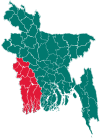Kalaroa Upazila
This article needs additional citations for verification. (March 2015) |
Kalaroa
কলারোয়া | |
|---|---|
| Coordinates: 22°52.5′N 89°2.5′E / 22.8750°N 89.0417°E | |
| Country | |
| Division | Khulna Division |
| District | Satkhira District |
| Area | |
| • Total | 232.64 km2 (89.82 sq mi) |
| Population (2011) | |
| • Total | 237,992 |
| • Density | 1,000/km2 (2,600/sq mi) |
| Time zone | UTC+6 (BST) |
| Website | kalaroa |
Kalaroa (Bengali: কলারোয়া) is an upazila of Satkhira District in the Division of Khulna, Bangladesh, Kolaroa Upazila was established in 1983, 18 km Distance From District Headquarters, Kolaroa Bazar is one of the Prosperous and Successful Business Places in Satkhira District,
Geography
Kalaroa is located at 22°52′30″N 89°02′30″E / 22.8750°N 89.0417°E. It has 35,475 households and a total area of 232.64 km2.
Kalaroa borders Sharsha, Jhikargachha and Manirampur upazilas to the north, Satkhira Sadar and Tala upazilas to the south, Keshabpur, Manirampur and Tala upazilas and the Kobadak river to the east and Swarupnagar CD Block in North 24 Parganas district in the Indian state of West Bengal to the west.[1]
The main rivers are the Kopothakho, Betraboti, Sonai, and Ichamati River. Lohakura, Kumarnal, Dhandia, Joynagar, Murari Katy, Gonopatipur, Sonabaria, Kushudanga, Tulshidanga, Batra, Sreerampur, Bujtola, Kazirhat, Khorda, Saraskati, and Chandanpur are the most famous villages in Kalaroa.
Demographics
According to the 2011 Bangladesh census, Kalaroa had a population of 237,992. Males constituted 49.08% of the population and females 50.92%. Muslims formed 93.89% of the population, Hindus 5.19%, Christians 0.76% and others 0.15%. Kalaroa had a literacy rate of 50.94% for the population 7 years and above.[2]
According to the 1991 Bangladesh census, Kalaroa had a population of 190,721. Males constituted 50.96% of the population, and females 49.04%. The population aged 18 or over was 97,044. Kalaroa had an average literacy rate of 25.6% (7+ years), compared to the national average of 32.4%.[3]
Arts and culture
Cultural organizations include 41 clubs, five public libraries, a public institute, three cinema halls, 12 women's organizations, 27 playgrounds, and a Kishore theatre.
The locally published newspapers and periodicals are Pathikrit, Samatat, Suryashikha, Subarna Prasun, and Dalchhut.
Religious institutions include 405 mosques, eight temples and three churches.
Administration
Kalaroa Upazila is divided into Kalaroa Municipality and 12 union parishads: Chandanpur, Diara, Helatala, Jallabad, Jogikhali, Joynagar, Kaila, Keragachhi, Keralkata, Kushadanga, Langaljhara, and Sonabaria. The union parishads are subdivided into 112 mauzas and 136 villages.[4]
Kalaroa Municipality is subdivided into 9 wards and 9 mahallas.[4]
Education
The oldest educational institution of Kalaroa is the Dhandia Union Institution which was established in 1915. The average literacy rate is 25.4%, 33.2% among males and 17.6% among females.
There are five-degree colleges in the upazila. Honors level ones include Begum Khaleda Zia Mahabiddalay, Hazi Nasir Uddin College, Kalaroa Government College, and Sheikh Amanullah Degree College. Pass level ones include Bongobondhu Mohila College and Sonar Bangla Degree College. Other educational institutions include 4 technical institutions, 31 high schools, 6 junior high schools, 64 madrassas (notably Brozobaksha Islampur Madrasha and Kalaroa Alia Madrasha), 67 government primary schools, 45 non-government primary schools, 12 low-cost primary schools, and 5 satellite schools. Noted educational institutions include Sonabaria Sammilita Secondary School (1967) Murarikati Taraknandi Primary School (1881), Kaila High School (1983), Dhandia High School (1885), Kalaroa GKMK Pilot High School (1930), Girls' Pilot High School (1968) and Khorda M.L High School (1959).
There is a Shahid Minar near the Upazila post office.
Notable residents
- Habibul Islam Habib Ex- Member of Parliament-105, Satkhira-1, Bangladesh National Parliament, Publicity and Publication Affairs Secretary Bangladesh Nationalist Party. Sheikh Amanullah, He was the president of the Jessore Education Board, a self-established Sheikh Amanullah Degree College in Kolaroa upazila,
References
- ^ "Kalaroa Upazila". Banglapedia. Retrieved 22 March 2016.
- ^ "Bangladesh Population and Housing Census 2011: Zila Report – Satkhira" (PDF). Table P01: Household and Population by Sex and Residence, Table P05 : Population by Religion, Age group and Residence, Table P09: Literacy of Population 7 Years & Above by Religion, Sex and Residence. Bangladesh Bureau of Statistics (BBS), Ministry of Planning, Government of the People’s Republic of Bangladesh. Retrieved 17 December 2018.
- ^ "Population Census Wing, BBS". Archived from the original on 2005-03-27. Retrieved November 10, 2006.
- ^ a b "District Statistics 2011: Satkhira" (PDF). Bangladesh Bureau of Statistics. Archived from the original (PDF) on 13 November 2014. Retrieved 14 July 2014.


